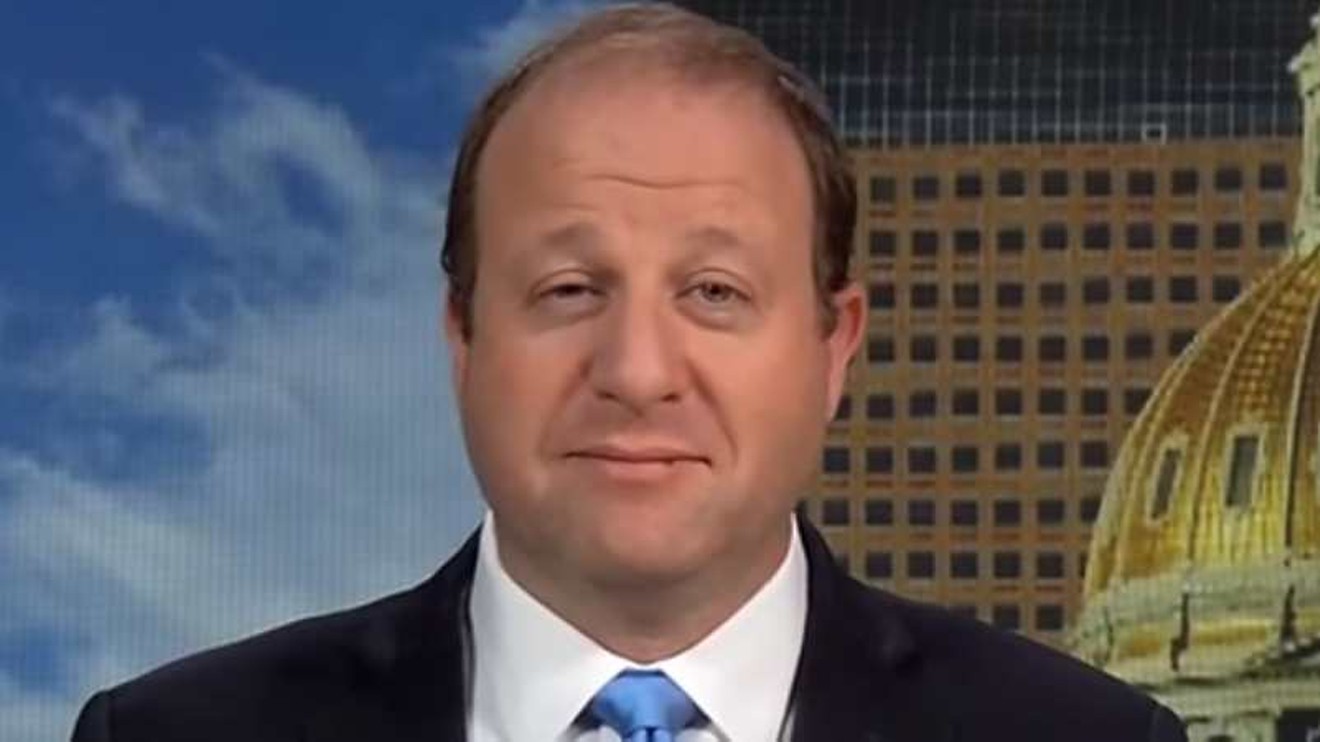During an April 20 press conference about Colorado's COVID-19 response, Governor Jared Polis offered details about what will follow the April 26 conclusion of the current stay-at-home order. He confirmed that some businesses will remain closed for weeks beyond that date, including bars and clubs, and restaurants won't be able to offer in-person dining right away, either. Moreover, non-critical retail outlets allowed to reopen will have to closely follow the sort of social-distancing guidelines and safety measures currently in use at places such as grocery stores, where mask-wearing for employees interacting with the public was mandated last week.
Early on in his remarks, Polis shared a mid-day statistical update from the Colorado Department of Public Health and Environment: 10,106 positive or presumptive-positive cases of the novel coronavirus, 880 hospitalizations, 1,096 successful discharges (including 215 during the past 24 hours) and 449 deaths.
The hospitalization numbers display what Polis characterized as "a slight downward trend," showing that Colorado has "stopped the exponential growth curve that would have overwhelmed the hospitals. ... Now we need to make this sustainable."
Another piece of good news from Polis's perspective: Eagle County has formally filed the state's first application to reopen. He's confident that officials there will be able to do so by week's end, and expressed his hope that he'll be on hand to sign the paperwork formalizing this new status.
Polis next discussed modeling conducted with the oversight of Colorado epidemiologist Dr. Rachel Herlihy, who subsequently took the podium and immediately grabbed attention with a strong statement: While the state officially has just over 10,000 positive cases, officials believe the actual number is closer to 65,000 to 75,000 people, or between 1.1 and 1.3 percent of the population as a whole.
Herlihy ran through six scenarios for procedures moving forward, and whether each one would be able to keep future COVID-19 cases from overwhelming a system that has around 2,000 intensive-care-unit beds available at present. Scenario A calls for maintaining a sustainable level of social distancing by the general public. Scenario B adds to this standard higher levels of social distancing for Coloradans age sixty and older, as well as those with pre-existing health conditions that make them more vulnerable. Scenario C supplements these approaches with mask-wearing in public. Scenario D also boasts aggressive case detection and containment. Scenario E combines A, C and D. And Scenario F uses all of these approaches.
If only Scenario A is instituted, she said, the ICU bed total in Colorado now will be insufficient by more than 1,000. But the other five scenarios should keep the state beneath the 2,000-bed threshold, with Scenario F holding the number of needed beds below 400.
Herlihy's takeaway: Colorado must maintain high levels of social distancing even after the stay-at-home order ends, with stricter compliance required of seniors — and strategies such as more testing, containment and mask-wearing will also better the state's odds of success.
Back at the podium, Polis stressed that overcoming the virus will be "a marathon, not a sprint...and I hate to break it to you, but the easy part was the sprint. Now we need to pace ourselves, and do it in a way that's different and has a lot less social interactions." People accustomed to ten social interactions per day will need to cut down to four or fewer, and those who take part in twenty must reduce them to eight, at least for the near term.
This will be especially necessary for people in their seventies, eighties and nineties. Perhaps one in ten members of the general population will require hospitalization after contracting the infection, he explained, but for older Coloradans, the range will be more like one in six or one in eight, with more negative outcomes. He likened the situation to a game of Russian roulette with one bullet in the chamber. For people in that older demographic, "Your May will look a lot like your April," Polis said, although limits could be loosened after May depending on what the data shows.
As for the rules that will guide the end of the stay-at-home order, they're currently in the works and should be finalized before April 26. But in general, Polis envisions a transitional period between April 27 and May 4, by which time around 50 percent of retail businesses should be open again, but under the sort of rules and regulations familiar to anyone who's had to shop for food: reduced capacities and spacing in aisles to maintain social distancing, the use of masks and the like. Elective surgery will also be allowed, and operations such as salons will be able to unlock their doors, too — but workers will need to wear masks there as well. And while real estate showings will also start up again, open houses will not, because of a limitation on gatherings to ten and under.
This last dictate means that schools will remain closed even after the stay-at-home order is lifted, as will bars, clubs and restaurants. Polis hopes that data from the first two weeks of May will be positive enough to justify the opening of eateries, perhaps at half-capacity — but the stats will determine if that's possible. The same goes for upping the number of retail businesses open to 70 percent or above. Meanwhile, counties will have leeway to shift procedures based on their specific conditions.
Overall, Polis was upbeat about the upcoming steps, but with a note of caution. "It's going to be touch-and-go for a while. We're not out of the woods yet, but we've successfully bent the curve," he said. "We just need to keep it under our capacity in the weeks and months ahead."
[
{
"name": "Air - MediumRectangle - Inline Content - Mobile Display Size",
"component": "12017618",
"insertPoint": "2",
"requiredCountToDisplay": "2",
"watchElement": ".fdn-content-body",
"astAdList": [
{
"adType": "rectangle",
"displayTargets": "mobile"
}
]
},{
"name": "Editor Picks",
"component": "17242653",
"insertPoint": "4",
"requiredCountToDisplay": "1",
"watchElement": ".fdn-content-body",
"astAdList": [
{
"adType": "rectangle",
"displayTargets": "desktop|tablet"
},{
"adType": "rectangle",
"displayTargets": "desktop|tablet|mobile"
}
]
},{
"name": "Inline Links",
"component": "18838239",
"insertPoint": "8th",
"startingPoint": 8,
"requiredCountToDisplay": "7",
"maxInsertions": 25
},{
"name": "Air - MediumRectangle - Combo - Inline Content",
"component": "17261320",
"insertPoint": "8th",
"startingPoint": 8,
"requiredCountToDisplay": "7",
"maxInsertions": 25,
"watchElement": ".fdn-content-body",
"astAdList": [
{
"adType": "rectangle",
"displayTargets": "desktop|tablet"
},{
"adType": "rectangle",
"displayTargets": "desktop|tablet|mobile"
}
]
},{
"name": "Inline Links",
"component": "18838239",
"insertPoint": "8th",
"startingPoint": 12,
"requiredCountToDisplay": "11",
"maxInsertions": 25
},{
"name": "Air - Leaderboard Tower - Combo - Inline Content",
"component": "17261321",
"insertPoint": "8th",
"startingPoint": 12,
"requiredCountToDisplay": "11",
"maxInsertions": 25,
"watchElement": ".fdn-content-body",
"astAdList": [
{
"adType": "leaderboardInlineContent",
"displayTargets": "desktop|tablet"
},{
"adType": "tower",
"displayTargets": "mobile"
}
]
}
]












